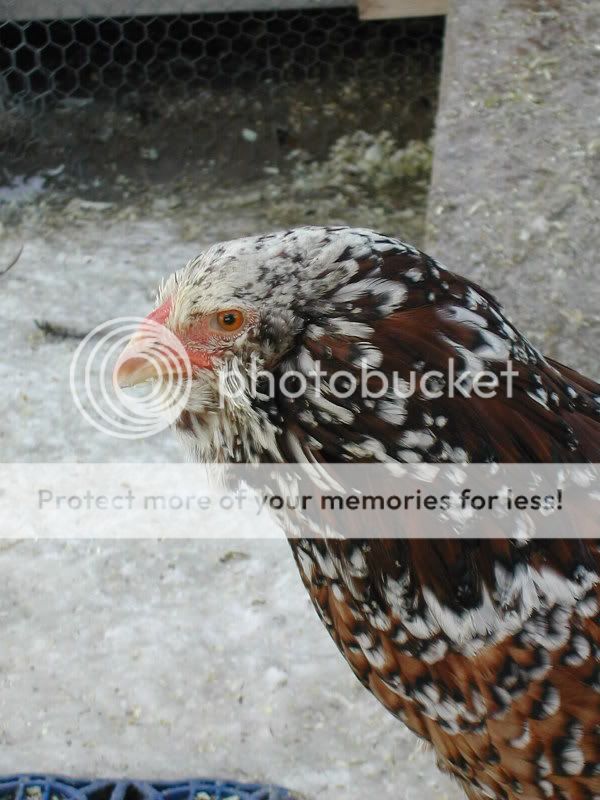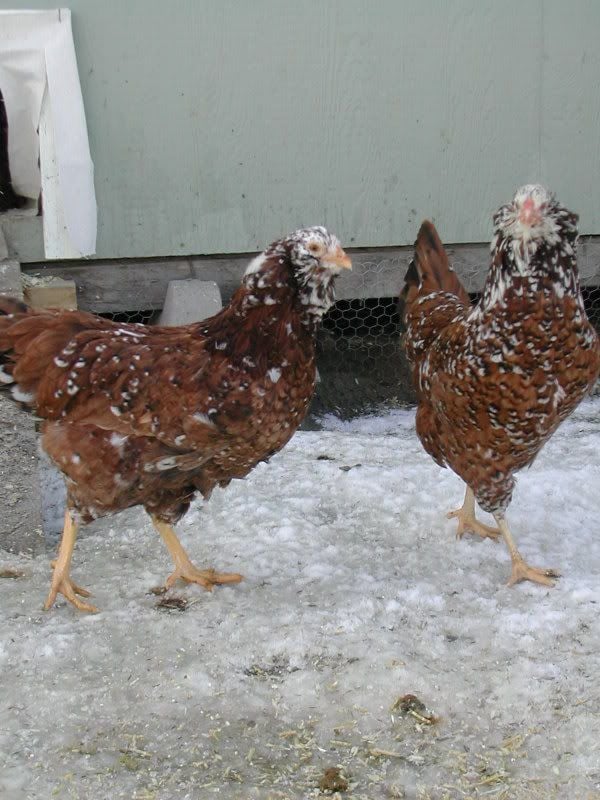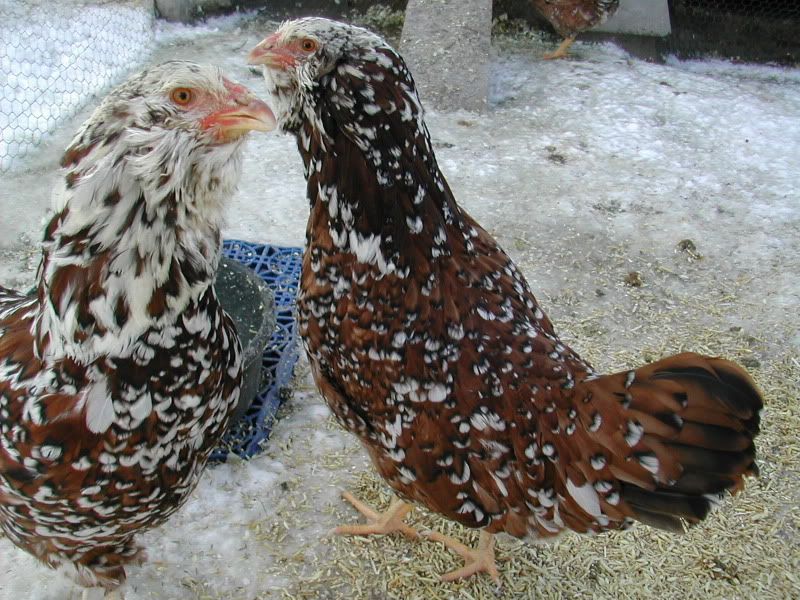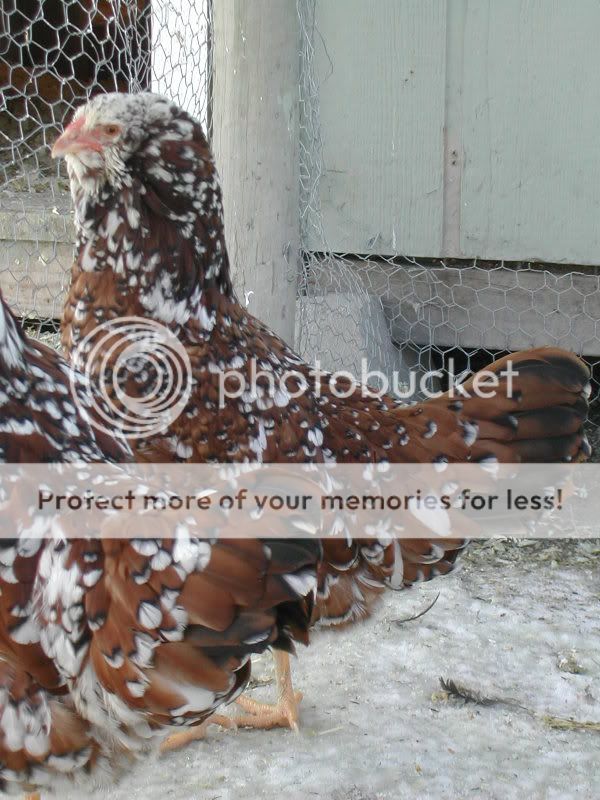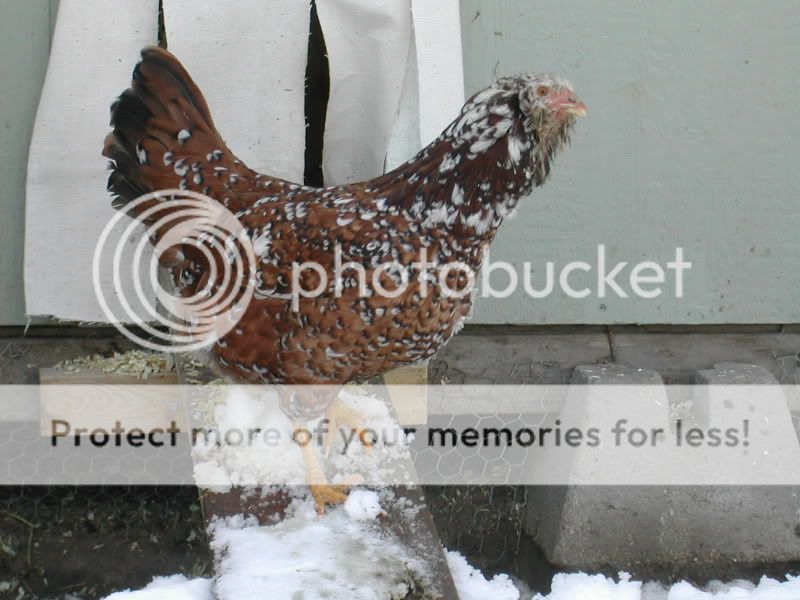I doubt that there are any real Orloffs here in the US.
Here is the info I have on them and this may have come from you Chris......I can't remember. I believe the Orloff that was in the SOP had a different comb, but I have to do some research to verify that.
Walt
Here is the info I have on them and this may have come from you Chris......I can't remember. I believe the Orloff that was in the SOP had a different comb, but I have to do some research to verify that.
Russians (the old APA standard)
Disqualifications
Combs other than rose; decidedly wry tails; crooked backs; pure white in any part of the plumage extending over one-half of an inch, or two or more feathers tipped or edged with positive white.
Standard Weights
Cock: 8 1/2 lbs
Cockerel: 7 1/2 lbs
Hen: 6 1/2 lbs
Pullet: 5 1/2 lbs
The Male
HEAD: Of good size and well formed:
BEAK: short, stout, well curved, and black or dark horn color
EYES, full, prominent, bright, bay or dark bay
FACE, red
COMB: Rose, narrow at the rear, without spike, and bright red.
WATTLES, EAR-LOBES AND BEARD:
WATTLES: long, pendant, well rounded, and bright red
EAR-LOBES: of medium size and bright red
BEARD: full, heavy under the beak, extending around in a curve to the back of the eyes
NECK: Of medium length, well arched, with hackle descending well upon the shoulders
BACK: Broad and tapering to the tail
SADDLE FEATHERS: abundant
BREAST: Round and full
BODY AND FLUFF:
BODY: broad and compact
FLUFF: moderately full
WINGS: Of medium size and well folded
TAIL: Of medium size, carried in an erect position
SICKLE FEATHERS: rather short
LEGS AND TOES:
THIGHS: of medium length and strong
SHANKS: of medium length, strong, and in color dark lead
TOES: the same as shanks in color
COLOR OF PLUMAGE: Green, glossy black throughout, except fluff and primaries and secondaries of the wings, which are black.
The Female
HEAD: Of medium size and well formed
BEAK: short, stout, well curved, and black or dark horn color
EYES: full, prominent, bright, bay or dark bay
FACE, red
COMB: Rose, similar to that of the male, but smaller, and bright red
WATTLES, EAR-LOBES AND BEARD:
WATTLES: small, well rounded, and bright red
EAR-LOBES: of medium size and bright red
BEARD: full on the throat, and extending around in a curve to the hackle
NECK: Of medium length, slightly arched, with full hackle
BACK: Moderately broad, and tapering to the tail
BREAST: Round and full
BODY AND FLUFF:
BODY: rather broad and compact
FLUFF: moderately full
WINGS: Of medium size and well folded
TAIL: Of medium size and moderately erect
LEGS AND TOES:
THIGHS: of medium length and strong
SHANKS: of medium length, strong, and in color dark lead
TOES: the same as shanks in color
COLOR OF PLUMAGE: Glossy black, with more or less green lustre, throughout, except fluff and primaries and secondaries of the wings, which are black.
http://www.feathersite.com/Poultry/CGK/Orloffs/Orl_CraigR.html
History
The Orloff has never been popular in this country, possibly because the standard is for a gloomy and vindictive expression. However they are a good hardy breed that sometimes take to laying in the winter months which makes them very useful. Although they are officially classed as originating from Russia there is much to indicate they originated in Persia (Iran) in the Gilan Province area where it was known as the Chilianskaia, and were then developed in Russia and named after Count Orloff Techmanski before coming to Britain in the 1920's. Probable breeds used in their makeup include the Malay or Belgian game and a bearded European Spangled breed.
Purpose-Dual
Classification-Heavy / Rare
Origin-Russia
Egg Color-Tinted
Egg Numbers-160 per annum
http://www.poultrypages.com/orloff.html
Feathersite has pics of Spangled, Cuckoo, Mahagony, White and Black Orloffs
http://www.feathersite.com/Poultry/CGK/Orloffs/BRKOrloff.html
This site has a chart of rare breeds, links and their basic characteristics including the Orloff
http://www.ithaca.edu/staff/jhenderson/chooks/chooks.html
There are some other interesting links and more reading on there, too.Disqualifications
Combs other than rose; decidedly wry tails; crooked backs; pure white in any part of the plumage extending over one-half of an inch, or two or more feathers tipped or edged with positive white.
Standard Weights
Cock: 8 1/2 lbs
Cockerel: 7 1/2 lbs
Hen: 6 1/2 lbs
Pullet: 5 1/2 lbs
The Male
HEAD: Of good size and well formed:
BEAK: short, stout, well curved, and black or dark horn color
EYES, full, prominent, bright, bay or dark bay
FACE, red
COMB: Rose, narrow at the rear, without spike, and bright red.
WATTLES, EAR-LOBES AND BEARD:
WATTLES: long, pendant, well rounded, and bright red
EAR-LOBES: of medium size and bright red
BEARD: full, heavy under the beak, extending around in a curve to the back of the eyes
NECK: Of medium length, well arched, with hackle descending well upon the shoulders
BACK: Broad and tapering to the tail
SADDLE FEATHERS: abundant
BREAST: Round and full
BODY AND FLUFF:
BODY: broad and compact
FLUFF: moderately full
WINGS: Of medium size and well folded
TAIL: Of medium size, carried in an erect position
SICKLE FEATHERS: rather short
LEGS AND TOES:
THIGHS: of medium length and strong
SHANKS: of medium length, strong, and in color dark lead
TOES: the same as shanks in color
COLOR OF PLUMAGE: Green, glossy black throughout, except fluff and primaries and secondaries of the wings, which are black.
The Female
HEAD: Of medium size and well formed
BEAK: short, stout, well curved, and black or dark horn color
EYES: full, prominent, bright, bay or dark bay
FACE, red
COMB: Rose, similar to that of the male, but smaller, and bright red
WATTLES, EAR-LOBES AND BEARD:
WATTLES: small, well rounded, and bright red
EAR-LOBES: of medium size and bright red
BEARD: full on the throat, and extending around in a curve to the hackle
NECK: Of medium length, slightly arched, with full hackle
BACK: Moderately broad, and tapering to the tail
BREAST: Round and full
BODY AND FLUFF:
BODY: rather broad and compact
FLUFF: moderately full
WINGS: Of medium size and well folded
TAIL: Of medium size and moderately erect
LEGS AND TOES:
THIGHS: of medium length and strong
SHANKS: of medium length, strong, and in color dark lead
TOES: the same as shanks in color
COLOR OF PLUMAGE: Glossy black, with more or less green lustre, throughout, except fluff and primaries and secondaries of the wings, which are black.
http://www.feathersite.com/Poultry/CGK/Orloffs/Orl_CraigR.html
History
The Orloff has never been popular in this country, possibly because the standard is for a gloomy and vindictive expression. However they are a good hardy breed that sometimes take to laying in the winter months which makes them very useful. Although they are officially classed as originating from Russia there is much to indicate they originated in Persia (Iran) in the Gilan Province area where it was known as the Chilianskaia, and were then developed in Russia and named after Count Orloff Techmanski before coming to Britain in the 1920's. Probable breeds used in their makeup include the Malay or Belgian game and a bearded European Spangled breed.
Purpose-Dual
Classification-Heavy / Rare
Origin-Russia
Egg Color-Tinted
Egg Numbers-160 per annum
http://www.poultrypages.com/orloff.html
Feathersite has pics of Spangled, Cuckoo, Mahagony, White and Black Orloffs
http://www.feathersite.com/Poultry/CGK/Orloffs/BRKOrloff.html
This site has a chart of rare breeds, links and their basic characteristics including the Orloff
http://www.ithaca.edu/staff/jhenderson/chooks/chooks.html
Walt


